.png?width=1400&name=Introducing%20AP%20Microfine%2010%20(1).png)
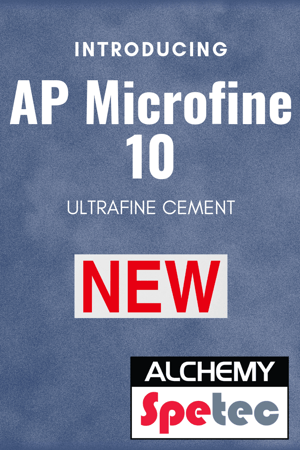 A Microfine Cement from Alchemy-Spetec
A Microfine Cement from Alchemy-Spetec
AP Microfine 10 is a blast furnace slag ultrafine cement intended for use in specialty grouting applications. With a D95 particle size of ten microns and a D50 particle size of three microns, this microfine cement is able to penetrate very small openings such as soil pores and microscopic rock fissures in order to improve strength and reduce permeability.
Advantages
- Excellent permeability.
- Environmentally friendly.
- Long-term durability.
- Highly adaptable.
- Brine tolerant.
- Highly predictable.
Applications
- Pre and post-excavation grouting.
- Water cut-off grouting.
- Dam and embankment grouting.
- Foundation stabilization, new and existing.
- Soil consolidation.
- Oil and gas well remediation.
- Hazardous waste containment grouting.
- Maintenance grouting of existing dams and tunnels.
Packaging
- 44 lb (19.96 kg) plastic pail.
- 6 oz (0.17 kg) bottle of plasticizer included.
Want more information on Alchemy-Spetec Geotech products?

Topics:
All Posts,
Stabilize Soil
.png?width=1400&name=Showroom%20Floor%20Slab%20Repair%20(1).png)
.png?width=300&name=Showroom%20Floor%20Slab%20Repair%20(2).png) Concrete Leveling & Stabilization for Showroom Floors
Concrete Leveling & Stabilization for Showroom Floors
Do you own or manage a business with concrete showroom floors? Auto dealers, large wholesale stores, convention centers and other businesses need strong and stable floor slabs to function properly. Unstable slabs can put merchandise, customers and even ownership at risk. See our two-part blog series on trip hazards and litigation risks...
Concrete Leveling to Prevent Trip Hazards & Litigation Risks - Part 1
Concrete Leveling to Prevent Trip Hazards & Litigation Risks - Part 2
You should also understand the larger danger of complete slab collapse if the voids underneath your floor are large enough. See this stunning security cam footage from the National Corvette Museum for an example in action. Ownership was completely unaware of the large voids that eventually caused this showroom floor to collapse, taking all those Corvettes with it.
Concrete Leveling & Stabilization Contractors
Alchemy-Spetec can help you find a contractor to detect, level, and stabilize slabs at risk. Even if you aren't noticing any immediate problems, it may be worth getting your slabs tested for dangerous voids lurking beneath. Call us now at 404-618-0438 for help finding a contractor in your area!
Want more info on commercial & industrial slab repair?

Topics:
All Posts,
Lift Slabs,
Stabilize Soil,
Fill Voids

.png?width=300&name=Loading%20Dock%20Slab%20Repair%20(1).png) Sunken concrete slabs can be lifted back into place with two-component polyurethane foams designed to work in wet or dry conditions. The expansion force of the concrete leveling foam coupled with the pressure of a specialized pump generate enough controlled force to lift virtually any structure back into position with 1/8” precision.
Sunken concrete slabs can be lifted back into place with two-component polyurethane foams designed to work in wet or dry conditions. The expansion force of the concrete leveling foam coupled with the pressure of a specialized pump generate enough controlled force to lift virtually any structure back into position with 1/8” precision.
- From the Alchemy-Spetec blog post Polyurethane Slab Lifting Explained. (Read more and watch an animation that explains the slab lifting process in detail.)
If you own or manage a facility with loading docks, it is essential to understand the dangers of unstable concrete. Warning signs include rocking, cracking, and unlevel seams between slabs. If you notice any of these red flags, you need to contact a professional concrete repair contractor immediately. (For assistance on that front, contact Alchemy-Spetec at 404-618-0438.)
This very real risks of ignoring unstable loading dock slabs include:
- Damage to vehicles and equipment.
- Personal property damage.
- Sudden slab collapse.
- Trip hazards.
- Employee injuries.
- Limitless liability issues.
As industry experts consulting with contactors around the world, we've seen all these scenarios play out unfortunately. Here's a photo from a slab collapse that prompted the owners to call in a contractor to inspect and stabilize the rest of their slabs...
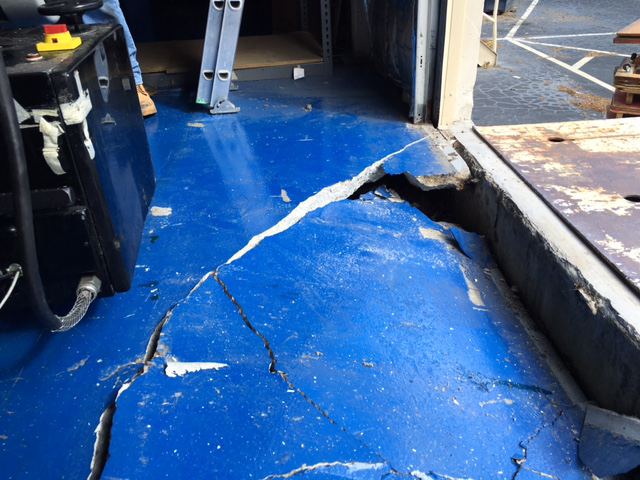
Don't wait for this to happen on your property. Contact Alchemy-Spetec at the first sign of any issue and let us help you find a contractor in your area! Call now at 404-618-0438.
Want more information on warehouse & industrial slab repair?

Topics:
All Posts,
Lift Slabs,
Stabilize Soil
-2.png?width=1400&name=Reminder%20-%202019%20Fall%20Training%20on%20October%209th%20%26%2010th%20(1)-2.png)
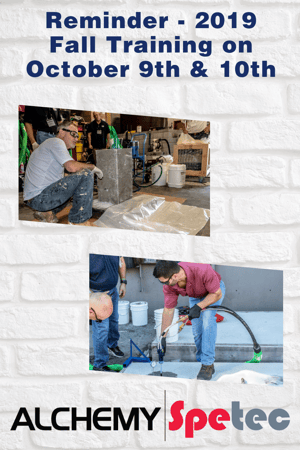
You still have a chance to sign up for Fall 2019 Training while there are still spots left. Don't miss this critical opportunity to turbo-charge your business!

October 9th & 10th, 2019 at Alchemy-Spetec HQ in Tucker, GA
Get ready for a thorough education in Leak Seal, Slab Lifting, Soil Stabilization and the Alchemy-Spetec Deep Lift™ process. You’ll get hands-on training from a technical staff with decades of on-the-job experience.
Wednesday - Leak Seal
- Leak Seal Product Line Overview
- Curtain Grouting
- Permeation Grouting
- Leak-Seal Product Mixing
- Pump & Packer Overviews
- Leak-Seal Accessories
- Municipal Applications
- Live Injection Demos
- Open Discussions
Thursday - Geotech
- Geotech Product Line Overview
- Soil Stabilization
- Geotech Product Mixing
- Rig & Mobile System Overviews
- Geotechnical Accessories
- Slab Lifting Live Demo
- Deep Lift™ Overview
- Soil Testing with the
- GPR & Penetrometer
- Maintenance Discussions
- Pricing / Estimating / Cost Savings
- Open Discussions

Participants receive a Samsung tablet loaded with training material.
Your Instructors:
Stephen C. Barton (President/CEO), Jim Spiegel (VP Sales & Business Development), Andy Powell (Southeastern Regional Manager), Anthony Sandone (Eastern Regional Manager), Charlie Lerman (Western Regional Manager), and Michael Binyaminov (Western Sales Representative).
Topics:
Repair Seawalls,
Equipment & Accessories,
All Posts,
Lift Slabs,
NSF Certification,
Seal Leaks,
Stabilize Soil,
Business Tips,
Repair Cracks,
Waterstop,
Deep Lift,
Floor Repair,
Fill Voids,
Engineer Resources
-1.png?width=1400&name=Reminder%20-%202019%20Fall%20Training%20on%20October%209th%20%26%2010th%20(1)-1.png)
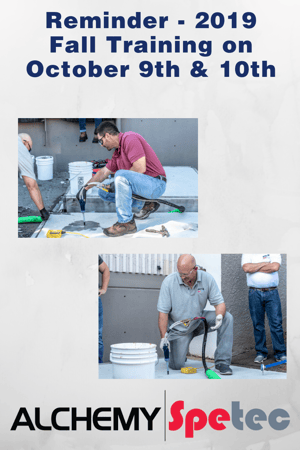
Sign up for Fall 2019 Training while there are still spots left!

October 9th & 10th, 2019 at Alchemy-Spetec HQ in Tucker, GA
Get ready for a thorough education in Leak Seal, Slab Lifting, Soil Stabilization and the Alchemy-Spetec Deep Lift™ process. You’ll get hands-on training from a technical staff with decades of on-the-job experience.
Wednesday - Leak Seal
- Leak Seal Product Line Overview
- Curtain Grouting
- Permeation Grouting
- Leak-Seal Product Mixing
- Pump & Packer Overviews
- Leak-Seal Accessories
- Municipal Applications
- Live Injection Demos
- Open Discussions
Thursday - Geotech
- Geotech Product Line Overview
- Soil Stabilization
- Geotech Product Mixing
- Rig & Mobile System Overviews
- Geotechnical Accessories
- Slab Lifting Live Demo
- Deep Lift™ Overview
- Soil Testing with the
- GPR & Penetrometer
- Maintenance Discussions
- Pricing / Estimating / Cost Savings
- Open Discussions

Participants receive a Samsung tablet loaded with training material.
Your Instructors:
Stephen C. Barton (President/CEO), Jim Spiegel (VP Sales & Business Development), Andy Powell (Southeastern Regional Manager), Anthony Sandone (Eastern Regional Manager), Charlie Lerman (Western Regional Manager), and Michael Binyaminov (Western Sales Representative).
Topics:
Repair Seawalls,
Equipment & Accessories,
All Posts,
Lift Slabs,
NSF Certification,
Seal Leaks,
Stabilize Soil,
Business Tips,
Repair Cracks,
Waterstop,
Deep Lift,
Floor Repair,
Fill Voids,
Engineer Resources
.png?width=1400&name=Specifications%20for%20Permeation%20Grouting%20with%20Polyurethane%20(2).png)
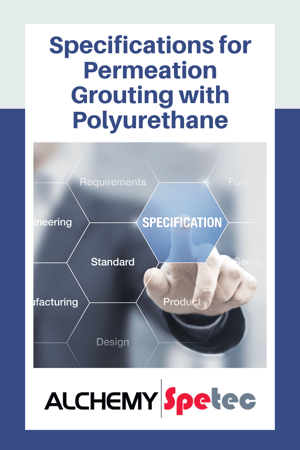
Today, we’ll take a look at the specification Permeation Grouting with Polyurethane. The specification includes documentation on the following:
- Stabilization, consolidation, and binding of water bearing soils through permeation injection of polyurethane resin creating a solid mass of soil and rigid resin.
- Creation of a barrier in water bearing soils to reduce water migration through permeation injection of polyurethane resin creating a solid mass of soil and rigid resin.
Click this link, Permeation Grouting with Polyurethane, to view a PDF of the specification. It thoroughly documents the installation process for one component, moisture activated, low viscosity, hydrophobic polyurethane (in our case, AP Soil 600 stabilization foam). For a copy of the specification in Microsoft Word format, please call Alchemy-Spetec at 404-618-0438.
If you scroll to the bottom of the Alchemy-Spetec downloads page, you’ll see a list of engineering specifications for Concrete Repair with Polyurethane.
Want more information on Alchemy-Spetec products?


Topics:
All Posts,
Stabilize Soil,
Engineer Resources
.png?width=1400&name=Reminder%20-%202019%20Fall%20Training%20on%20October%209th%20%26%2010th%20(2).png)
.png?width=300&name=Reminder%20-%202019%20Fall%20Training%20on%20October%209th%20%26%2010th%20(1).png) Don't forget to sign up for Fall 2019 Training!
Don't forget to sign up for Fall 2019 Training!

October 9th & 10th, 2019 at Alchemy-Spetec HQ in Tucker, GA
Get ready for a thorough education in Leak Seal, Slab Lifting, Soil Stabilization and the Alchemy-Spetec Deep Lift™ process. You’ll get hands-on training from a technical staff with decades of on-the-job experience.
Wednesday - Leak Seal
- Leak Seal Product Line Overview
- Curtain Grouting
- Permeation Grouting
- Leak-Seal Product Mixing
- Pump & Packer Overviews
- Leak-Seal Accessories
- Municipal Applications
- Live Injection Demos
- Open Discussions
Thursday - Geotech
- Geotech Product Line Overview
- Soil Stabilization
- Geotech Product Mixing
- Rig & Mobile System Overviews
- Geotechnical Accessories
- Slab Lifting Live Demo
- Deep Lift™ Overview
- Soil Testing with the
- GPR & Penetrometer
- Maintenance Discussions
- Pricing / Estimating / Cost Savings
- Open Discussions

Participants receive a Samsung tablet loaded with training material.
Your Instructors:
Stephen C. Barton (President/CEO), Jim Spiegel (VP Sales & Business Development), Andy Powell (Southeastern Regional Manager), Anthony Sandone (Eastern Regional Manager), Charlie Lerman (Western Regional Manager), and Michael Binyaminov (Western Sales Representative).
Topics:
Repair Seawalls,
Equipment & Accessories,
All Posts,
Lift Slabs,
NSF Certification,
Seal Leaks,
Stabilize Soil,
Business Tips,
Repair Cracks,
Waterstop,
Deep Lift,
Floor Repair,
Fill Voids,
Engineer Resources

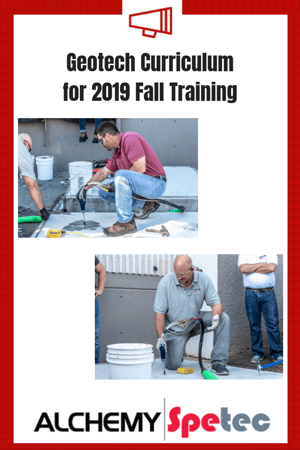
Get ready for a thorough education in polyurethane slab lift/soil stabilization geotech products and applications on Thursday, October 10th (October 9th is leak seal day), 2019 at Alchemy-Spetec HQ in Tucker, GA. You’ll get hands-on training from a technical staff with decades of on-the-job experience. Registration includes both days, but we’ll take a close look at the geotech curriculum in today’s blog post…
The schedule on Thursday, October 10th includes education on the Alchemy-Spetec geotech product line, soil stabilization, slab lifting, the Deep Lift™ process, rig & mobile lifting systems, geotech accessories, soil testing (ground penetrating radar, penetrometer), pricing and estimating. There will also be live geotech demos, product mixing demos, and open discussions for sharing job related tips and solutions from the field.
Your instructors have years of experience providing technical support for contractors across the country. You can look forward to presentations, demos and/or discussions lead by Stephen C. Barton (President/CEO), Jim Spiegel (VP Sales & Business Development), Andy Powell (Southeastern Regional Manager), Anthony Sandone (Eastern Regional Manager), and Charlie Lerman (Western Regional Manager).
Participants will receive a Samsung tablet loaded with leak seal training material.
Sign up while there's still space available...

Topics:
Equipment & Accessories,
All Posts,
Lift Slabs,
Stabilize Soil,
Business Tips,
Deep Lift

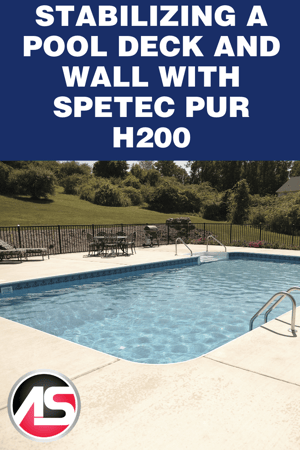
Today’s guest blogger is Bill Stivers, an experienced salesman at Alchemy-Spetec distributor Sunshine Supply.
As a Salesman at Sunshine Supply, I’ve dealt with a lot of leak seal products over the years. But I don’t often get the chance to try them out on my own property. I recently, however, had an issue with a leaking swimming pool in my own back yard. Water was draining through the seams between the slabs of my pool deck and causing erosion. In addition, ground squirrels and rabbits had been digging around the area over the years, causing further issues with soil displacement. The pool deck was destabilized along with the wall surrounding the pool. They had both slipped about a half an inch down a small hill on one side. Some bricks around the pool had settled about 2 inches. My extensive experience in this field told me that this was just the beginning of a much more serious problem. The leaking water had to be contained and the soil around the structures had to be stabilized immediately.
Due to my position at Sunshine Supply, I am familiar with a wide range of leak seal products, and there was one that I knew would be ideal for this job: Spetec PUR H200. We injected deep into the soil on the hillside via 6-foot injection pipes. We used an F-Valve to simultaneously inject water along with the resin to jump-start the reaction process. (The wet soil would have caused the resin to react anyways, but the added water kick started the reaction process for a quicker install of the material.) This process prevents the wall and pool deck from further slippage by stopping the seeping water and stabilizing the supporting soil.
If you live in any of the following areas and want to buy your leak seal supplies from distributors with expert knowledge of the products, make sure you contact Sunshine Supply at any of the following locations:
Want more information on Alchemy-Spetec leak seal products?

Topics:
All Posts,
Seal Leaks,
Stabilize Soil

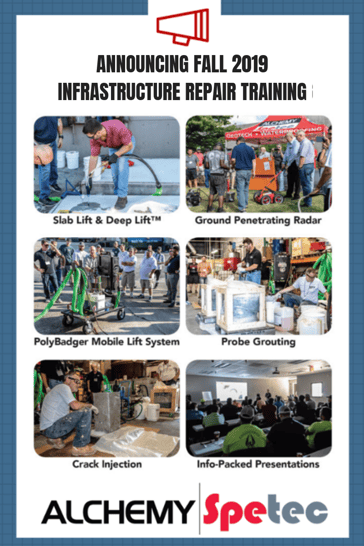 Leak Seal & Geotech Products & Procedures
Leak Seal & Geotech Products & Procedures
October 9th & 10th, 2019 at Alchemy-Spetec HQ in Tucker, GA
Get ready for a thorough education in Leak Seal, Slab Lifting, Soil Stabilization and the Alchemy-Spetec Deep Lift™ process. You’ll get hands-on training from a technical staff with decades of on-the-job experience.
Wednesday - Leak Seal
- Leak Seal Product Line Overview
- Curtain Grouting
- Permeation Grouting
- Leak-Seal Product Mixing
- Pump & Packer Overviews
- Leak-Seal Accessories
- Municipal Applications
- Live Injection Demos
- Open Discussions
Thursday - Geotech
- Geotech Product Line Overview
- Soil Stabilization
- Geotech Product Mixing
- Rig & Mobile System Overviews
- Geotechnical Accessories
- Slab Lifting Live Demo
- Deep Lift™ Overview
- Soil Testing with the
- GPR & Penetrometer
- Maintenance Discussions
- Pricing / Estimating / Cost Savings
- Open Discussions

Participants receive a Samsung tablet loaded with training material.
Your Instructors:
Stephen C. Barton (President/CEO), Jim Spiegel (VP Sales & Business Development), Andy Powell (Southeastern Regional Manager), Anthony Sandone (Eastern Regional Manager), Charlie Lerman (Western Regional Manager), and Michael Binyaminov (Western Sales Representative).
Topics:
Repair Seawalls,
Equipment & Accessories,
All Posts,
Lift Slabs,
Seal Leaks,
Stabilize Soil,
Business Tips,
Repair Cracks,
Waterstop,
Deep Lift,
Floor Repair
 A Microfine Cement from Alchemy-Spetec
A Microfine Cement from Alchemy-Spetec
.png?width=1400&name=Introducing%20AP%20Microfine%2010%20(1).png)

.png?width=1400&name=Showroom%20Floor%20Slab%20Repair%20(1).png)
.png?width=300&name=Showroom%20Floor%20Slab%20Repair%20(2).png) Concrete Leveling & Stabilization for Showroom Floors
Concrete Leveling & Stabilization for Showroom Floors

.png?width=300&name=Loading%20Dock%20Slab%20Repair%20(1).png)


-2.png?width=1400&name=Reminder%20-%202019%20Fall%20Training%20on%20October%209th%20%26%2010th%20(1)-2.png)


-1.png?width=1400&name=Reminder%20-%202019%20Fall%20Training%20on%20October%209th%20%26%2010th%20(1)-1.png)

.png?width=1400&name=Specifications%20for%20Permeation%20Grouting%20with%20Polyurethane%20(2).png)


.png?width=1400&name=Reminder%20-%202019%20Fall%20Training%20on%20October%209th%20%26%2010th%20(2).png)
.png?width=300&name=Reminder%20-%202019%20Fall%20Training%20on%20October%209th%20%26%2010th%20(1).png) Don't forget to sign up for Fall 2019 Training!
Don't forget to sign up for Fall 2019 Training!




 Leak Seal & Geotech Products & Procedures
Leak Seal & Geotech Products & Procedures